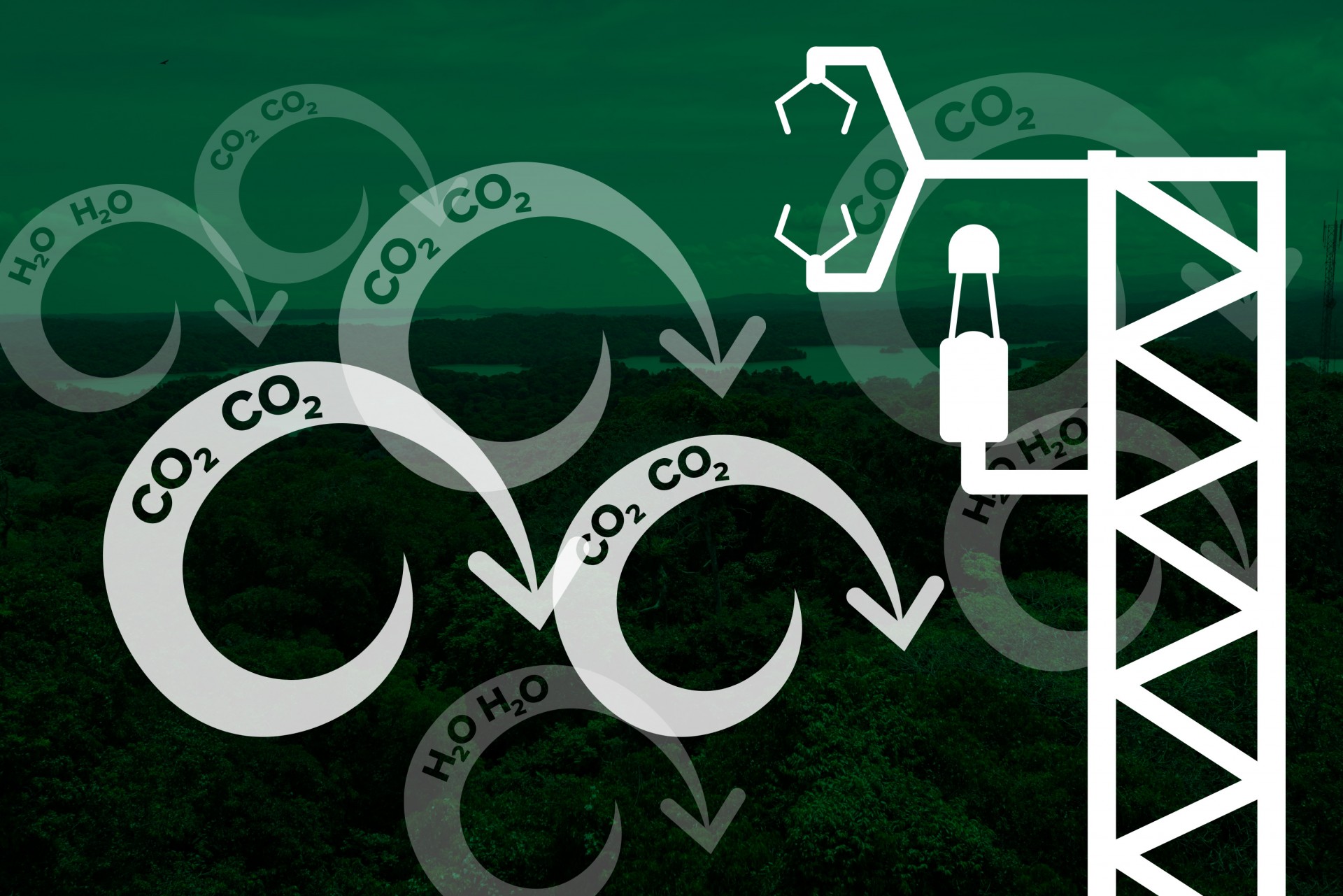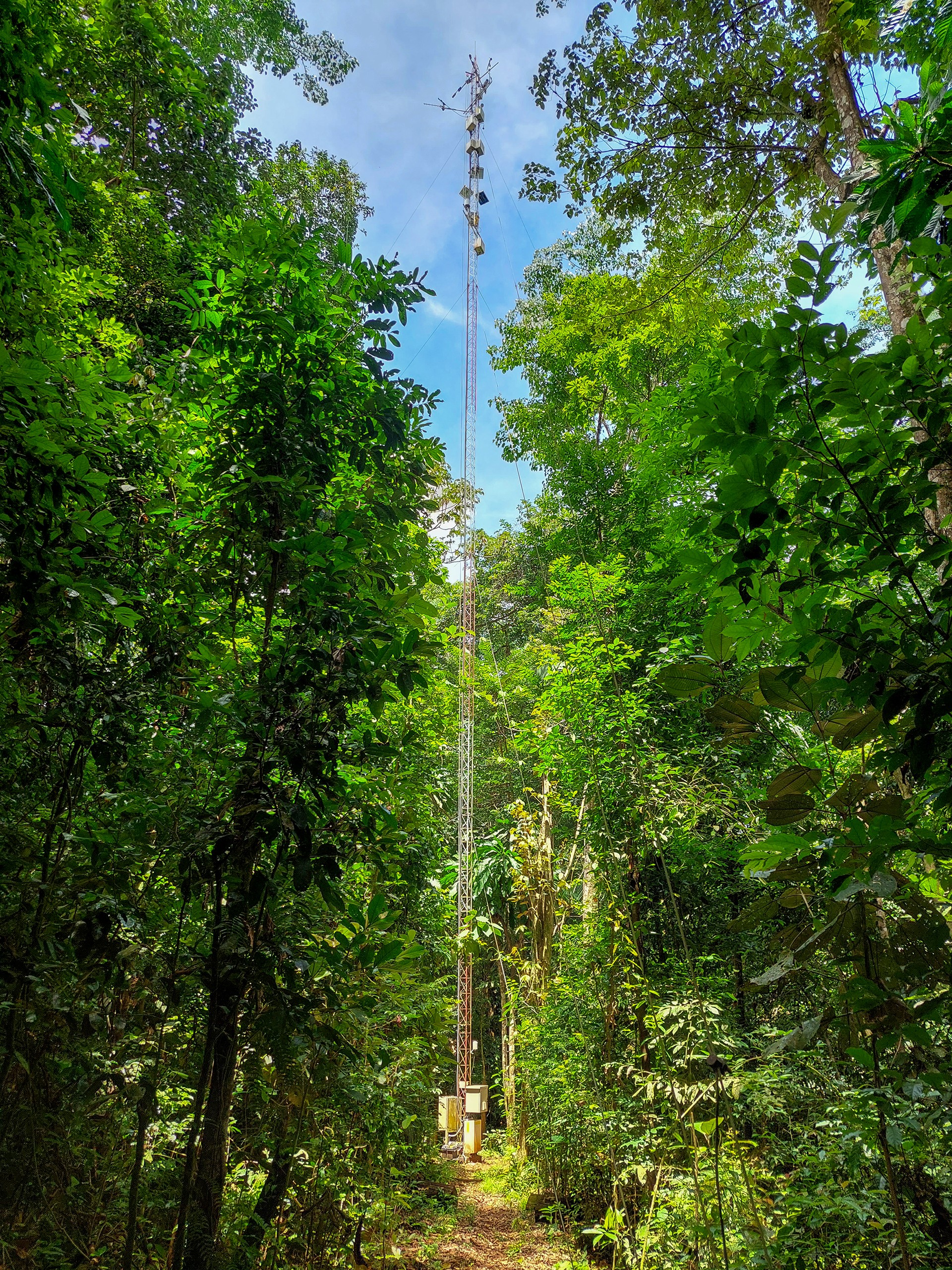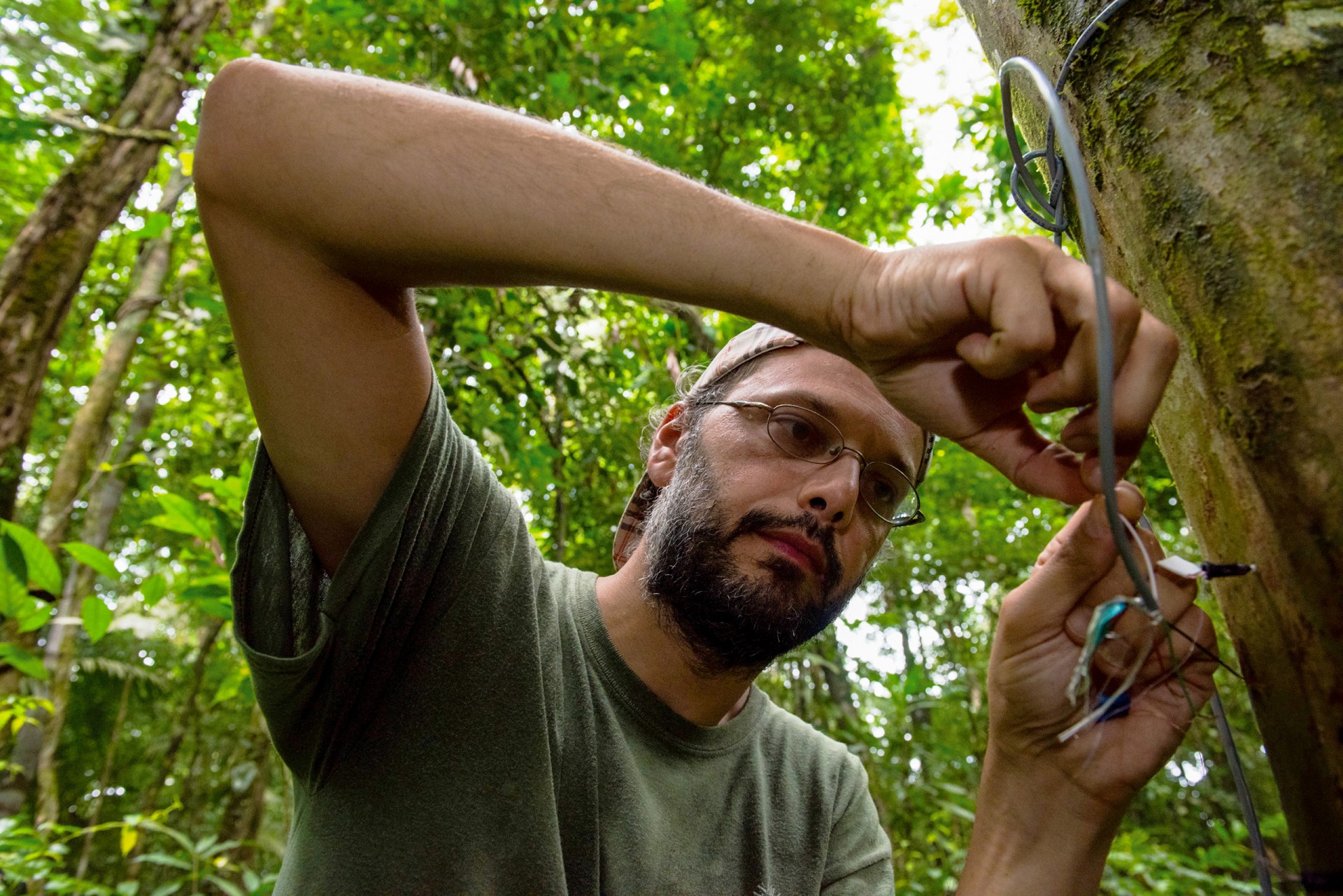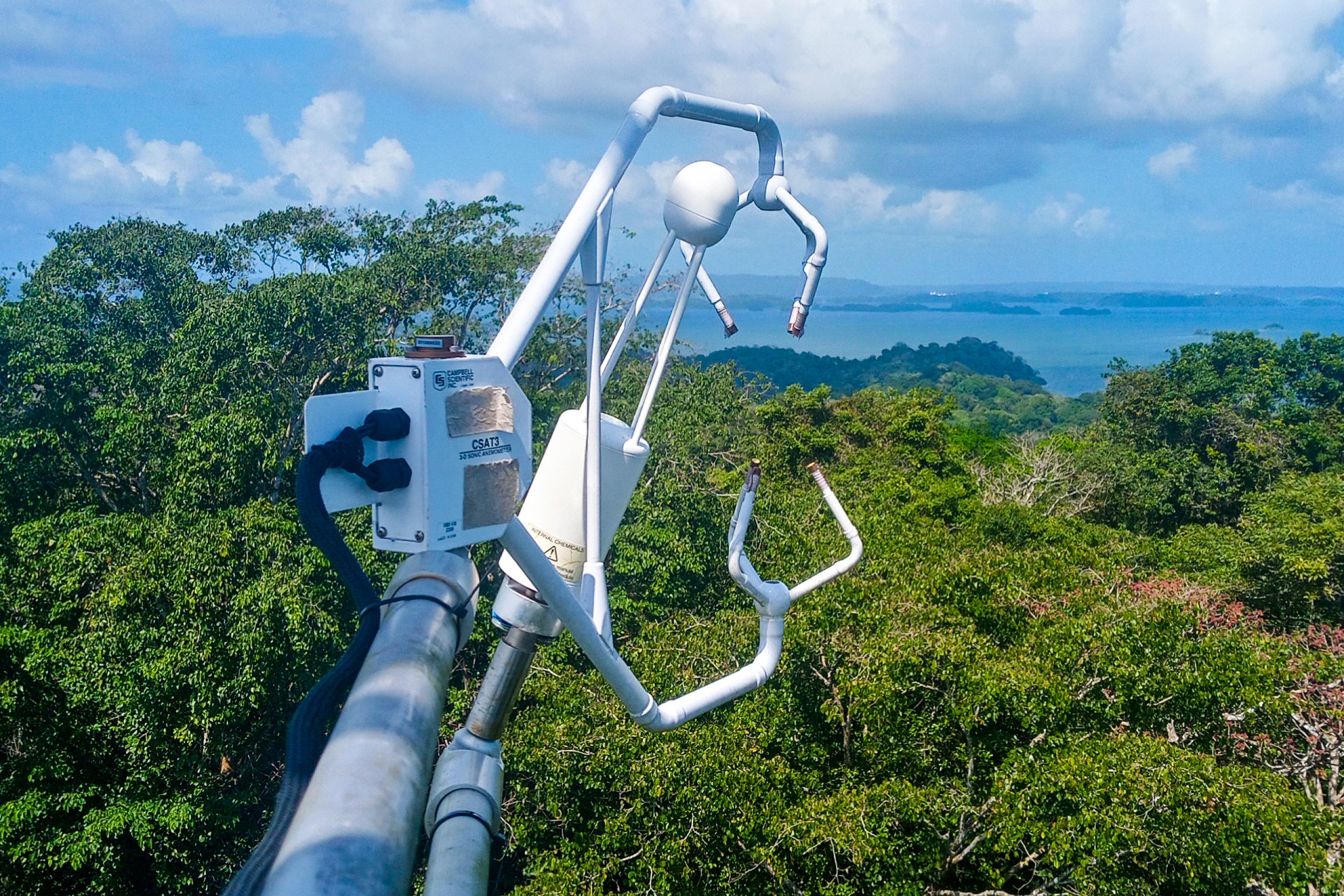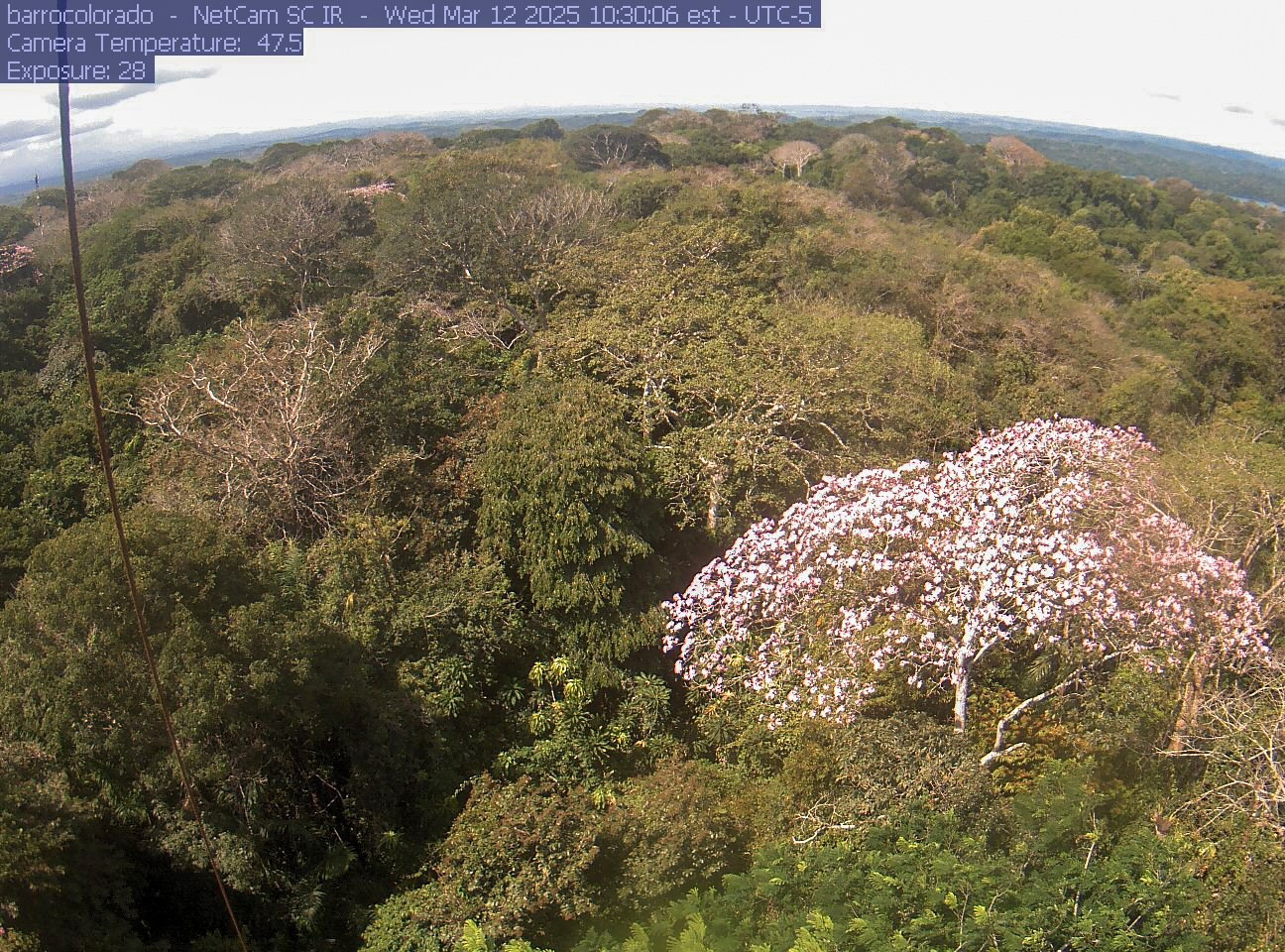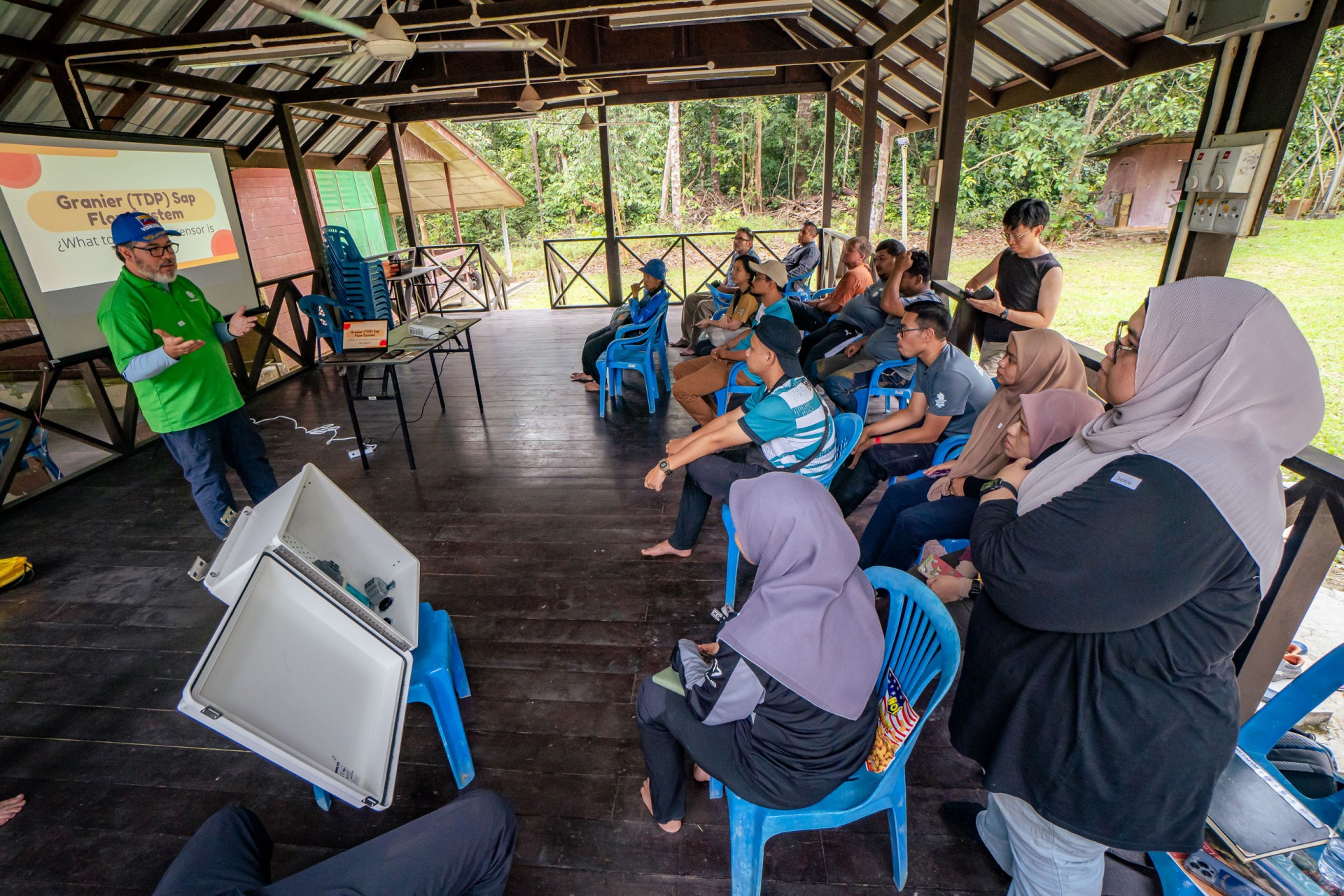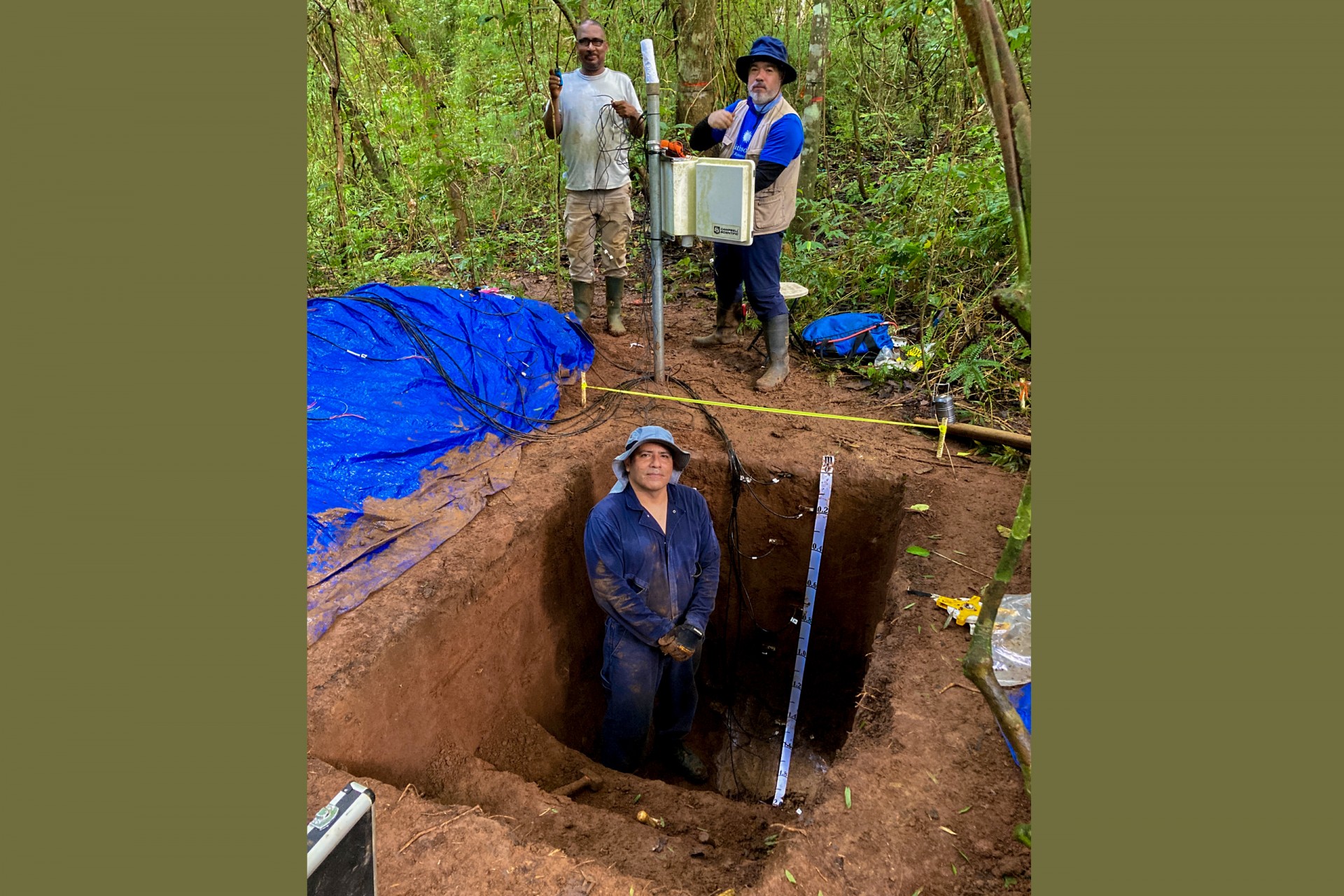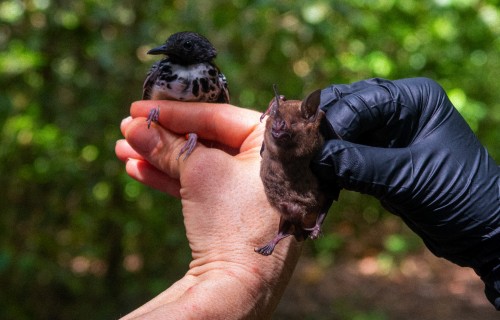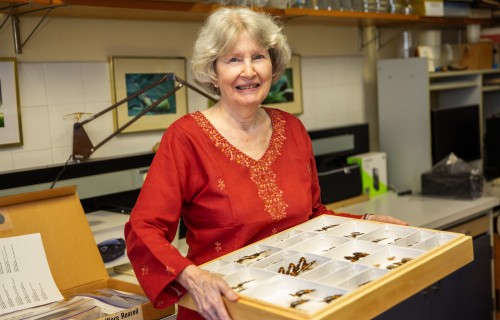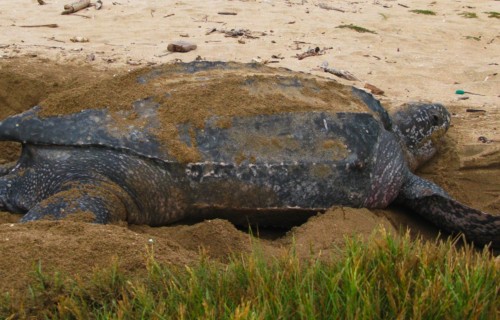Smithsonian science helps understand blue whale migratory and foraging patterns to inform conservation strategies
The forest
breathes
Above the tropical forest canopy,
sensors capture the fluxes of gases
between the trees and the atmosphere
By: Vanessa Crooks
The air moving above the forest carries valuable information about how trees absorb carbon, and what may happen in the future as global temperatures rise.
Just as humans inhale and exhale, forests absorb and release gases. There is a constant exchange of carbon dioxide (CO2), water vapor (H2O) and other gases between the soils, vegetation and air, which scientists measure to understand how much is released into the atmosphere, and how much is absorbed by plants and trees through photosynthesis.
This gas exchange is measured by a system called eddy covariance.
An eddy is air that moves circularly due to turbulence (changes in speed and direction). At night, temperatures drop and the air is more stable, and during the day, when temperatures rise, the air moves more; these fluctuations between day and night create the wind we feel, and therefore eddies, which move in different directions, carrying different concentrations of CO2, H2O and other gases.
The Eddy Covariance (EC) system is a technique for measuring the fluxes of energy and gases such as carbon dioxide and water vapor in eddies over the forest. These measurements indicate how much of these gases are absorbed or released by plants and soils through photosynthesis, and how much is rising into the atmosphere and contributing to global warming.
Illustration by Jorge Alemán, STRI
Covariance refers to simultaneously measuring the concentration of gases and the changes in the direction of the eddies, to understand how much carbon, water vapor, and energy are shifting and where, and how they change from moment to moment (fluxes). This is done with equipment called sonic anemometers, which measure wind speed and direction, and infrared CO2/H2O gas analyzers. That’s hundreds of measurements per minute in real time from these devices that detect how many molecules of these gases move through a defined area or volume, and how many rise into the atmosphere or are absorbed by forests.
"The Eddy Covariance (EC) system is a micro-meteorological technique used to directly monitor these exchanges between forests and the atmosphere, as these interactions are critical to understanding the role of forests within the global climate system," explains Matteo Detto, a researcher in the Department of Ecology and Evolutionary Biology at Princeton University, who installed the EC system at the AVA tower on Barro Colorado Island (BCI) in 2012.
"Carbon can be in many places, in the soil, in plants, in the atmosphere, and there's just no other way to track it, but this system does it," says Joe Wright, a staff scientist at the Smithsonian Tropical Research Institute (STRI).
At STRI, research technician Alfonso Zambrano manages and verifies the data collection of the EC system. "BCI's EC system has been operating continuously for the last ten years," says Zambrano. "It's important because it's a localized way of calculating gas exchange over the forest. And there are very few of these systems in the tropics."
The first AVA tower was built in 2012 as part of the ForestGEO network's climate monitoring program; Detto, then an associate staff scientist at STRI, added the EC system sensors, and managed them until 2017.
The AVA tower, called the “new AVA”, is located on Barro Colorado Island. This tower, which is 45 meters tall, contains the equipment of the Eddy Covariance system that capture data above the forest canopy.
Courtesy of Alfonso Zambrano
"I established the EC system on BCI to have more information about how tropical forests absorb carbon and use water, and how these fluxes respond to environmental variability," says Detto. "This monitoring is essential to understand how tropical forests react to environmental changes, such as droughts and warming, and how best to conserve them."
"The EC system captures data ten times per second, or 10 Hz (Hertz). And thanks to Matteo, we have approximately ten years’ worth of data," Wright says.
In 2019, the tower was rebuilt after a tree fell on it, and the sensors were reinstalled. Since then, the tower has been part of STRI's physical monitoring program.
Zambrano manages the EC system and its data locally. He periodically visits the tower to download data and monitor the energy supply system, and to perform preventive maintenance and replace the equipment when necessary; it’s not an easy task, since it involves frequently climbing up and spending several hours at the top of a 45m (approximately 147 ft) tall tower, more or less the equivalent of climbing a 12-story high building.
Matteo Detto, a researcher in the Department of Ecology and Evolutionary Biology at Princeton University, installed the EC system in the first AVA tower in 2012, and managed it until 2017, while he was an associate staff scientist at STRI.
Photo by Sean Mattson
In the tropics, this task is made even more difficult due to rains and storms that constantly affect the electronic equipment.
For that reason, Zambrano developed a website for the EC system, with the aid of STRI's Office of Information Technology (OIT), to monitor daily that the system is operational. This website also houses the information and databases of the system. Fixed phenological (the study of plants cycles) monitoring cameras, or Phenocams, also installed by Detto and Zambrano, capture photos of the forest canopy from the AVA tower and the BCI telecommunications tower, showing how it changes through the seasons and climactic conditions; STRI ArcGIS geographic information system specialist Milton Solano created the webpage from which to access this database.
"Maintaining this system in the tropics is complicated, so it's even more important that it can continue to generate data constantly, without long gaps," explains Zambrano. "We do everything to minimize this as much as possible, despite the difficulties of weather, lack of power, lightning failures, and any other unforeseen events that occur. And this makes it so relevant that this system exists in the tropics."
The EC system’s valuable data is open access through AmeriFlux, a global network of researcher-managed sites located in ecosystems throughout the Americas, that use eddy covariance to monitor energy, water, and carbon fluxes above many different types of ecosystems.
"There are hundreds of these eddy flux towers in North America and Europe, which are part of this network. Many have been working for decades, but in the tropics, there are only about a dozen," Wright says. "That's why data is extremely important."
Detto and Wright run this data through a quality control process before publishing it on AmeriFlux; so far, there are five years of data available.
"For the past ten years this system has provided a unique database, which is critical for understanding the functioning and resilience of tropical forests under changing conditions," says Detto.
Applying what we know so far
Zambrano, Wright and Detto also collaborate on NGEE-Tropics (Next-Generation Ecosystem Experiments–Tropics), a multi-institutional project that began in 2015, funded by the U.S. Department of Energy, the Office of Science and the Bureau of Biological and Environmental Research. The project brings together researchers from all over the world and research sites in places like Borneo, Australia, Brazil, French Guiana, Puerto Rico, Malaysia and Panama.
"In general, this project seeks to simulate what happens in tropical forests as temperatures increase," says Zambrano. Other STRI researchers, such as scientists Stuart Davies, Helene Muller-Landau and Martijn Slot, also collaborate with NGEE-Tropics.
"We contribute with the data we collect. NGEE-Tropics uses all that data to improve the representation of tropical forests in dynamic vegetation models," Wright explains.
A dynamic vegetation model (DVM) is a component of an Earth system model, representing the biosphere, life on earth; it includes global cycles of carbon, water, and more, to predict the future of climate, ocean currents, and the atmosphere. Tropical forests cover less than 7% of the Earth's surface, yet they recycle more carbon, water, and energy than any other biome. These exchanges between forests and the atmosphere are critical in regulating the Earth's climate.
"One of the big uncertainties in these models, which has prevented us from being able to predict the future of the climate more accurately," Wright continues, "is how tropical forests will respond to higher temperatures, global increases in atmospheric carbon, and changes in regional precipitation. How are they going to react? It’s guesswork. So, we use technology to provide data that helps fill those information gaps."
"The data generated by the tower in BCI is crucial to improve these ecosystem models, such as those developed by NGEE-Tropics, to predict how forests will behave in future climate scenarios," explains Detto. "And they rely on field observations like ours to calibrate and validate the models."
NGEE-Tropics also gathers other key weather and vegetation data, such as sap flows, ozone concentrations, temperature and soil moisture data. In Panama, STRI's canopy cranes in the Metropolitano Natural Park and the San Lorenzo National Park are essential sites for field studies over the forest canopy, such as obtaining leaf and branch samples for photosynthesis studies.
NGEE-Tropics' projections seek to be increasingly precise, to create more accurate and reliable models, through a platform of global climate models called E3SM-FATES (Energy Exascale Earth System Model – Functionally Assembled Terrestrial Ecosystem Simulator), to calculate the carbon emitted or absorbed by tropical forest ecosystems, simulating how ecological and physiological processes respond to environmental changes.
With this more accurate information, scientists and decision-makers are better positioned to formulate responses to environmental changes and assess the ability of tropical forests to sequester carbon now and in the future.
"Looking ahead, it is essential to maintain and expand this monitoring over the long term," Detto said. "Continuous measurements of fluxes are invaluable for detecting trends, understanding the long-term responses of tropical forests to climate change, and continue using cutting edge technology to provide the data needed to guide scientific knowledge and the conservation of the wellbeing of tropical ecosystems."

